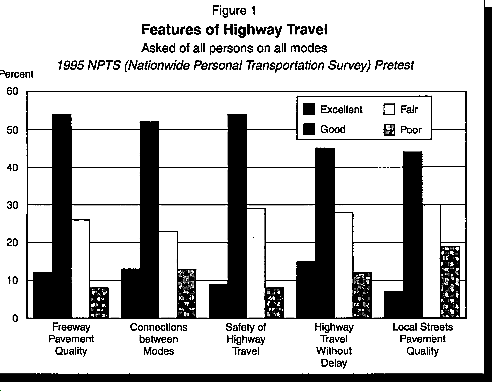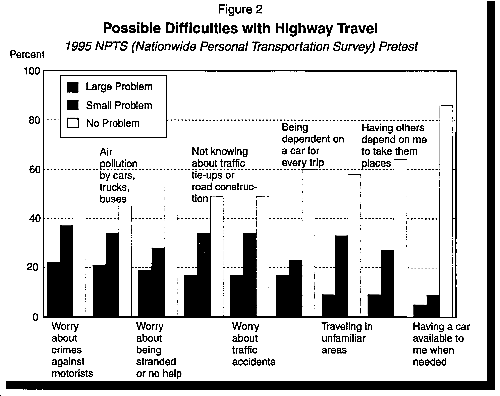Overall, the public's views of transportation are positive. There is, however, always room for improve-ment in our transportation facilities and the service provided in those areas. If you would like to learn more about the NPTS customer service results, contact Carol Harbaugh at (202) 366-0076, or Susan Liss at (202) 366-5060.
Data from the NPTS pretest, which was con-ducted from November 1994 through January 1995 through interviews with persons from 2,312 house-holds, provide a preview of trends that may appear in the completed survey. Pretest data show only relatively small changes since 1990 in the proportion of trips by purpose. Trip purposes include:
Other (includes changing means of transportation)
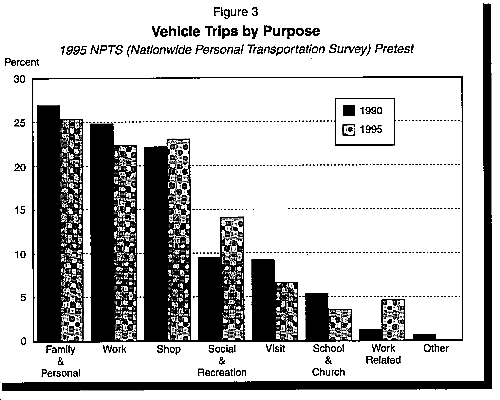 Figure 3 indicates that there has been a significant increase in percentage of vehicle trips for social and recreational and for work-related (i.e., work-related activities other than com-muting between home and work) purposes. Each of three purposes accounts for more than 20 percent of vehicle trips: family and personal business, to and from work, and shopping.
Figure 3 indicates that there has been a significant increase in percentage of vehicle trips for social and recreational and for work-related (i.e., work-related activities other than com-muting between home and work) purposes. Each of three purposes accounts for more than 20 percent of vehicle trips: family and personal business, to and from work, and shopping.
Figure 4, which shows vehicle miles instead of trips, presents a very different picture. Only one purpose, work-related travel, produces a signifi-cant increase over 1990.
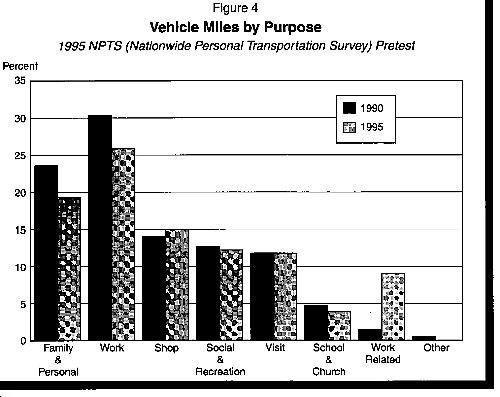 Two purposes, family and personal business and to and from work, show slight decreases. Travel to and from work, now as before, is clearly the most important generator of vehicle miles, although its share of total travel has dropped. Family and personal business and shopping show less impor-tance as producers of vehicle miles than trips, indicating shorter distances.
Two purposes, family and personal business and to and from work, show slight decreases. Travel to and from work, now as before, is clearly the most important generator of vehicle miles, although its share of total travel has dropped. Family and personal business and shopping show less impor-tance as producers of vehicle miles than trips, indicating shorter distances.
For more information, contact Carol Harbaugh at (202) 366-0076, or Susan Liss at (202) 366-5060.
Improved Outreach and Communication Between FHWA and the States
Working with the States and its other partners, FHWA's Office of Highway Information Manage-ment (OHIM) has identified several ways to improve outreach and communication between FHWA and the States. The efforts to improve outreach and communication are largely the result of the recom-mendations made by the Highway Statistics Steering Committee. The Steering Committee made recom-mendations that the OHIM could implement which would improve communication between FHWA and the States. Among these recommendations were (1) conduct regional training seminars, (2) provide lists of State data providers, and (3) explore the use of video-conferencing.
In a February 8 memo to its field offices, the OHIM requested assistance from the Regions in hosting regional training seminars and providing lists of State data providers. To date, FHWA Region 5 (Chicago) has agreed to conduct a seminar in December 1996 for interested States in that Region. In addition, the lists of State data providers are being furnished to the OHIM. A directory of data providers will be compiled so that information can be shared between State personnel and the FHWA.
As a means to further improve communication, the OHIM has agreed to use video-conferencing to broadcast certain segments of the annual Highway Statistics Seminar. Some regional offices will be used as video-conference sites. State personnel who may not otherwise be able to attend the seminar will have an opportunity to participate. FHWA regional and division offices are currently polling States for possible attendees.
If you would like more information on the outreach and communication efforts in which the OHIM is engaged, or if you are interested in a regional training seminar, please contact Teia McGee at (202) 366-5137.
Highway Performance Monitoring System (HPMS) Steering Committee
The second meeting of the HPMS Steering Committee was held on February 14 and 15, 1996, in Arlington, Virginia. After several introductory presentations, the Committee was charged with moving forward to identify priority issues of con-cern to the Committee, the development of action agendas, and the development of recommendations to FHWA.
At the end of an extensive discussion period, the Committee agreed on a list of six top priority issues--five that can be categorized as primarily short to medium term, and one that can be cate-gorized as being of longer term nature. The issues are summarized as follows:
1. HPMS Purpose and Need--Long Range
The Committee would like FHWA to focus on a strategic look at the future of the HPMS in light of highway legislation reauthorization, the National Highway System (NHS) approval, the reporting of highway needs to Congress, and the increased interest throughout Government in the use of per-formance indicators. FHWA agreed to develop an issues and concepts paper for undertaking a strategic look at the HPMS by the end of 1996.
2. Vehicle Miles Traveled (VMT) Estimating and Forecasting
The Committee would like FHWA to investigate the development of strategies and recommendations for addressing the issues and problems associated with traffic counting and forecasting in urbanized areas, in particular the problems associated with differing Metropolitan Planning Organization (MPO) and State HPMS-based estimates and forecasts of traffic and travel. Members of the Committee have drafted a discussion paper that has been provided to the whole Committee for com-ments. The development of further recommendations will follow. In the interim, FHWA will continue with its proposed visits to a selected set of States and MPO's to develop case studies on how traffic counts and travel estimates are prepared.
3. HPMS Training
The Committee would like FHWA to address the development of a training program for HPMS. The Committee provided a general recommendation to FHWA that a training program is needed, and recommended specific concerns and potential areas of investigation. FHWA will assess these recom-mendations and look into the development of a training program that can meet the identified needs and concerns.
4. Measuring Congestion
The Committee would like FHWA to investigate the development of an alternative to measuring congestion other than using the volume/service flow ratio, which is the current practice. Members of the Committee drafted a discussion paper that has been provided to the whole Committee for comments. The development of further recommendations will be deferred to a later time.
5. Truth in Data (Appropriate Uses)
The Committee would like FHWA to focus on fostering the appropriate uses of HPMS data by public and other users. The Committee provided general recommendations and concems to FHWA at the meeting, and FHWA agreed to develop a discus-sion paper for Committee review and input.
6. HPMS Refinements (Short Term)
The Committee would like FHWA to perform a short-term review of the HPMS with the objective of removing from the reporting requirements data items that are no longer used or are of marginal value. The Committee presented a list of items that are of particular concern and recommended that FHWA determine which of these items could be deleted from the reporting requirements. FHWA agreed to consider the recommendations for streamlining, and will report back to the committee at the next meeting.
Next Meeting: A third meeting has been scheduled for August 7-8, 1996, at the Crystal Gateway Marriott in Arlington, Virginia. For more information, contact Connie Bell at (202) 366-5068.
Travel on the National Highway System (NHS)
Although the NHS includes only 4 percent of the Nation's highways, it carries 43 percent of the total highway travel. Travel on the NHS is fairly evenly split between the Interstate system segments of the NHS (54%) and the non-Interstate segments of the NHS (46%) (see Figure 5). Travel on the NHS is relatively uncongested even during peak periods (88%). In urban areas, mileage of the NHS operating under highly congested conditions during peak periods includes 22 percent of the total NHS urban mileage. For rural areas, a comparable statistic shows only 2 percent of the total NHS rural mileage operating under highly congested conditions during peak periods (see Figure 6).
For more information, contact Paul Svercl at (202) 366-5036.
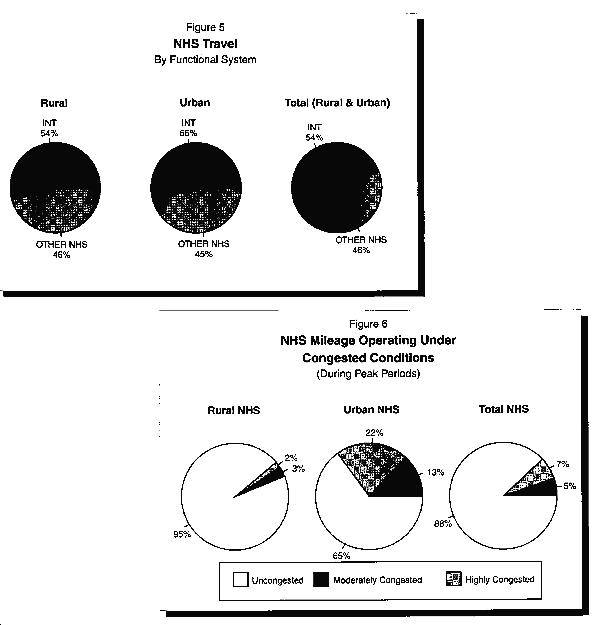
NOTES FROM THE FIELD
Floating Car Method: Single-Person Operation in Collecting Travel Time Data
The Indian Nations Council of Governments (INCOG) implemented travel time data collection for the Tulsa, Oklahoma, region in November 1995. The data are collected by one person (driver) with the assistance of a laptop computer. INCOG did a brief survey of methods to collect travel time data for congestion management purposes. The method is borrowed from the California Department of Trans-portation using Distance Measuring Instruments (DMI). Utilizing the same technology, INCOG implemented the cost-effective method to collect data. The steps are shown below for connecting the instruments together. The actual runs begin with the selection of an expressway, and all the exits are noted. The driver operates a single key, which is used when the exit marker is passed. The distance and time are automatically recorded by the laptop. Incremental distance and incremental time are calculated and the average speed between exits is derived from the data. Any recurring congestion can be easily identified using a sufficient number of samples.
Initial Steps Used
1. Connected Transmission Sensor to the Vehicle Transmission
2. Connected Car Battery to the Distance Measuring Instrument
3. Connected the Sensor to DMI and Run a Test and Calibrate the DMI
4. Connected DMI and Laptop Computer-Loaded with Appropriate Software
For more information concerning the project, contact Viplava K. Putta at INCOG, Tulsa, at (918) 584-7526, or FAX (918) 583-1024.
This article is in response to the September 1995 edition of this newsletter, which asked for articles from the field. If you would like to share any new approaches to data collection and data manipulation being utilized in your organization, contact Bryant Gross at (202) 366-5026, FAX (202) 366-7742, or e-mail your idea to
GROSS @ INTERGATE.DOT. GOV.
FHWA Reducing Local Financial Reporting Requirement
FHWA is phasing out its requirement for the local government version of FHWA-534 "Highway Capital Outlay and Maintenance Expenditures" form. This change was announced in an April 19, 1996, FHWA memo shared with State officials. The Highway Statistics Steering Committee, a Federal/ State advisory body to FHWA on general statistical programs, advised FHWA to consider this action. The local government FHWA-534 is one of the reports required of State and local governments as part of the statistical reporting process. Up to this time, reporting was on a biennial basis. For the 1995 data, due June 15, 1997, States will only be required to provide a single consolidated local government FHWA-534 for all functional systems, classifying expenditures on the NHS by improvement type. For future reporting years, the local government version of form FHWA-534 will be entirely eliminated and form FHWA-536, "Local Highway Finance Report," will be expanded slightly for NHS data. As a result of this reduction in reporting burden, State and local governments are estimated to save about 20,000 reporting hours annually. This equates to about $475,000. The majority of the relief will be for the thousands of local government data providers who report local capital spending by system and type of improvement. States, which survey the local govern-ments for these data and compile local results, will also benefit from the reduced burden.
In addition to the burden placed on the State and local governments, quality and completeness issues in the current local government version of FHWA-534 reports were compelling reasons in the decision to phase it out. Significantly, essential NHS data currently reported on the local FHWA would be captured through the modification to an existing FHWA finance reporting form.
For more information, contact Leonard Goldberg at (202) 366-5024.
Back to Reports


